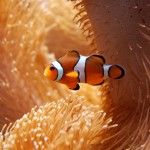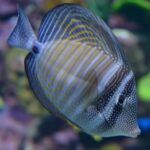If you’ve been an aquarium enthusiast for a while, you’ve probably kept some type of goby at one point or another. There are endless goby species out there, many of which are suitable for aquarium life – too many to be able to cover here. That’s why we’re discussing 7 of our favorite gobies today, just to give you a peek at what’s out there!
Keep reading for a list of 7 of our favorite colorful aquarium goby species.

Firefish goby (Nemateleotris magnifica)
Members of the genus Nemateleotris are often referred to as dartfish, and although there is some discussion on their status, they have been classified as probably belonging to the family Gobiidae. Good enough for us to include them in this list, in any case!
The small firefish goby (Nemateleotris magnifica) is a classic aquarium species. It’s not difficult to see why: these guys are beautiful to look at, peaceful and reef-safe, as well as suitable for smaller set-ups (20 gallons and up for a solo specimen or a pair).
Firefish gobies are natural plankton eaters and can be maintained on a diet of small frozen and live fish foods. Be sure to provide yours with plenty of hides, as these guys do like a place to retreat to when they feel threatened.
You can read all about this species in the firefish goby care guide.
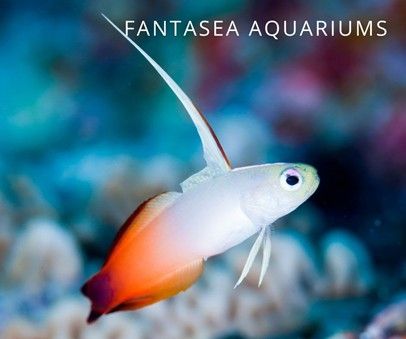
Black-ray goby (Stonogobiops nematodes)
Also known as the antenna goby, barber pole goby and many other names, Stonogobiops nematodes is one of the various species of prawn gobies. These fish maintain a symbiotic relationship with certain species of shrimp, sharing a burrow and keeping an eye out for possible threats. The shrimp’s job is to maintain their hide, even covering the entrance at night to keep unwanted visitors out.
Black-ray gobies will pair up with shrimp in the aquarium, giving you the chance to view this fascinating behavior up close. They’re reef safe and like an environment with some nooks and crannies in order to feel safe.
If you’d like to see your black-ray goby pair up with a shrimp, you can go for the genus Alpheus, better known as pistol shrimp or snapping shrimp. Do make sure you do a bit of research, because these invertebrates are carnivores that are likely to prey on other shrimp species. They don’t hunt and kill fish or break the aquarium glass like some sources suggest, though.
Did you know? Like many goby species and fish in general, this one is known to jump when startled. Keep a tight lid on the aquarium to prevent yours from going “carpet surfing”.

Yellow watchman goby (Cryptocentrus cinctus)
Another prawn goby, this one lends its common name from the lookout position the goby holds in its symbiotic relationship with pistol shrimp. Yellow watchman gobies are a great, colorful option for aquariums of 20 gallons and up, leaving their tankmates alone as long as they’re not other gobies.
Your yellow watchman goby will appreciate a sandy substrate in the aquarium, as the species likes to burrow. They’re not picky eaters and reef safe, so they can be combined with corals just fine.
You can read all about this species in the yellow watchman goby care guide.
Did you know? Gobies tend to be peaceful towards other species, but can get extremely territorial and aggressive with their own. Unless you own a proven pair or keep them in a very large aquarium, it’s probably better to go for a solo goby.
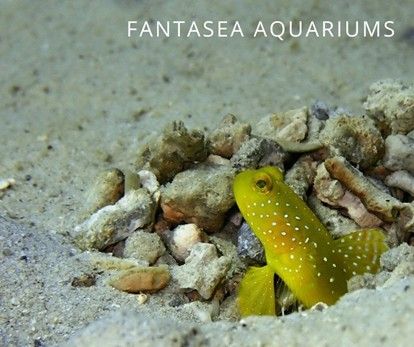
Diamond goby (Valenciennea puellaris)
Valenciennea is a genus also known as the sleeper gobies, of which the diamond goby (Valenciennea puellaris) is probably the most commonly kept in aquariums. This bottom dweller is a bit larger than the other gobies we’ve discussed so far, so an aquarium of 55 gallons or up is your best bet if you’d like to keep one. Tankmates should be on the calm side, as this is a peaceful goby that won’t bother anyone that doesn’t come too close to its burrow.
Sleeper gobies like this one are sand sifters. This means they’ll appreciate a sandy substrate to dig around and forage in, although you should still supplement your diamond goby’s diet with normal frozen foods to make sure it doesn’t starve. They’re usually not picky eaters.
You’ll never have to worry about a dirty substrate with one of these in your tank, although you should make sure any live rock is positioned well to avoid it falling over when the sand shifts.
You can read all about this species in the diamond goby care guide.

Bumblebee goby (Brachygobius sp.)
Here’s one for the brackish fishkeepers, which (sorry!) we don’t always pay enough attention to. The teeny tiny bumblebee goby is found in coastal areas in Thailand and Indonesia where rivers feed into the sea, often with thick mangrove vegetation.
These are not the best for beginning aquarists due to their specific needs, but definitely make for a fun option for a single-species set-up where other fish can’t bother them. A 15-20 gallon aquarium works fine for a group: this is the only species on the list that mostly plays nice with its own species and doesn’t have to be kept individually or in mated pairs. Territorial squabbles do occur, but as long as there’s plenty of space on the bottom of the tank, you’re unlikely to see real trouble.
Bumblebee gobies appreciate a slight salinity of up to 1.010; despite what some sources claim, they won’t do well in fully fresh nor marine water. Be prepared to feed live foods if necessary, because these guys aren’t the easiest to get to accept commercial aquarium foods.
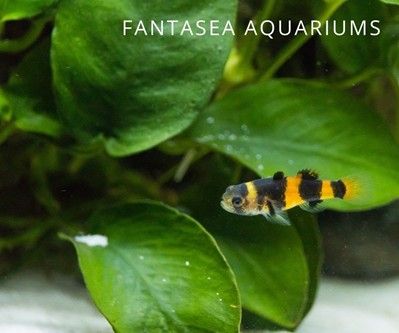
Yellow clown goby (Gobiodon okinawae)
Isn’t the tiny yellow clown goby just the most adorable thing?! Its bright yellow coloration is sure to brighten up any aquarium and due to its size (1.5”), the species makes the perfect choice for nano tanks of 10 gallons and up.
Yellow clown gobies can be a bit difficult to get used to frozen foods in the aquarium, but you should usually be able to get yours to take small meaty bits eventually. The species is known to occasionally nip at stony corals if it gets hungry and can take up Acropora specifically as a host, bothering it in the process. Still, these gobies are considered mostly reef safe and won’t be able to do significant damage.
Did you know? It probably goes without saying that a fish as small as this one shouldn’t be kept with larger species that might eat it, but if any tankmates do ever attempt to take a bite, your yellow clown goby is not entirely defenseless. These guys are covered in a layer of mucus that apparently tastes vile!
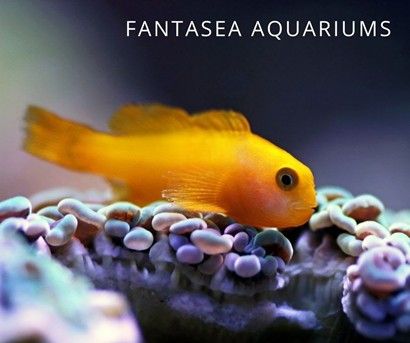
Rainford’s goby (Amblygobius rainfordi)
The colorful, striped Rainford’s goby (also known as the court jester goby or old glory) is an omnivorous sand sifter naturally found in the Western Pacific. It reaches a maximum size of only around 2” and can be kept in aquariums of 20 gallons and up as long as the tank is stocked with similarly peaceful species.
Like the previously mentioned yellow clown goby, your Rainford’s goby may struggle to recognize regular aquarium fish foods and can starve in the aquarium if you don’t keep a close eye on it. As much as you probably hate them, filamentous algae are one of this species’ favorite foods and you’d do well to leave some in the tank for your specimen to graze on.

Conclusion
Gobies are the perfect bottom dwelling choice for a beautiful reef aquarium, as long as you don’t try to combine multiple – the territorial battles can be epic and even fatal.
If you’re dreaming of a fish tank in your home or aquarium, we can help! Contact FantaSEA Aquariums here with your ideas so we can design, build and maintain your dream tank for you.


